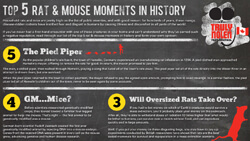 Click image for full infographic[/caption]
Click image for full infographic[/caption]
Household rats and mice are pretty high on the list of public enemies, and with good reason: for hundreds of years, these mangy, disease-ridden rodents have instilled fear in disgust in humans by causing illness and discomfort in all parts of the world.
If you’ve never had a first-hand encounter with one of these creatures in your home and can’t understand why they’ve earned such a negative reputation, read through our list of the top 5 rat & mouse moments in history and form your own opinion:
5. The Pied Piper
As the popular children’s tale has it, the town of Hamelin, Germany experienced an overwhelming rat infestation in 1284. A pied-clothed man approached Hamelin’s mayor, offering to remove the rats for good. In return, the mayor promised to pay him.
The man, a skilled piper, then walked through Hamelin, playing a song that lured all of the town’s rats away. The pied piper led all of the rats directly into the Weser River in an attempt to drown them, but one survived.
When the pied piper returned to the town to collect payment, the mayor refused to pay the agreed upon amount, prompting him to exact revenge. In a similar fashion, the pied piper led all of Hamelin’s children out of the town, never to be seen again by some accounts.
4. GM…Mice?
Before scientists researched genetically modified crops, they looked toward a familiar four-legged animal for help: the mouse. That’s right — the first animal to be genetically modified was a mouse.
German-born scientist Rudolf Jaenisch created the first ever genetically modified animal by injecting DNA into a mouse embryo. Genes from the injected DNA were present in every cell as the mouse grew, advancing genetics and human disease research.
Not a bad contribution.
3. Will Oversized Rats Take Over?
If you had to bet money on which of Earth’s creatures would survive a mass extinction, you’d probably place your money on the cockroach. After all, they’re able to withstand doses of radiation 10 times higher than what would be lethal to humans, can survive over a month without food, and can reproduce quickly and in large amounts.
Well, if you put your money on these disgusting bugs, you may have to pay up: experiments conducted by British researchers have shown that rats are the best suited mammals for survival and repopulation in a mass-extinction scenario.
The researchers cited a rat’s ability to infiltrate, adapt, and populate in hostile environments. And, because they’d find a new home at the top of the food chain, they’ll become larger. The experiments consider the timeframe for the changes to the Earth in 2 to 3 million years, meaning we won’t be here to see these giant, terrifying creatures.
2. The One Rat to Rule them All
Rats may be social animals, but they don’t have a very strong sense of hierarchy. There aren’t soldier rats and worker rats like you’d see in a bee colony, but there is a king rat.
A king rat isn’t one single rat, though, and you’re unlikely to see one unless you visit a museum that houses one of the 50 ever reported in the world. Similar to how you’d king a checker’s piece, a king rat is actually several rats bound together by tangled tails.
The largest known rat king considered of 32 individual, fully grown rats, and is currently on display in the Mauritianum Museum in Altenburg, Germany.
1. The Black Plague
The 14th Century’s bubonic plague or “The Black Death” was a disease that quickly claimed the lives of an estimated 25 million Europeans, an estimated 30% of the continent’s population at the time.
The bubonic plague was a zoonotic disease, meaning it originated from an animal. That animal is none other than the rat, who carried fleas with the bacteria that began the massive outbreak.
The Black Death is a tragic story, but all the more reason to understand why we call rats and mice “vectors for disease.” Even though these rodents may not be infected, they often carry creatures like fleas that do.

